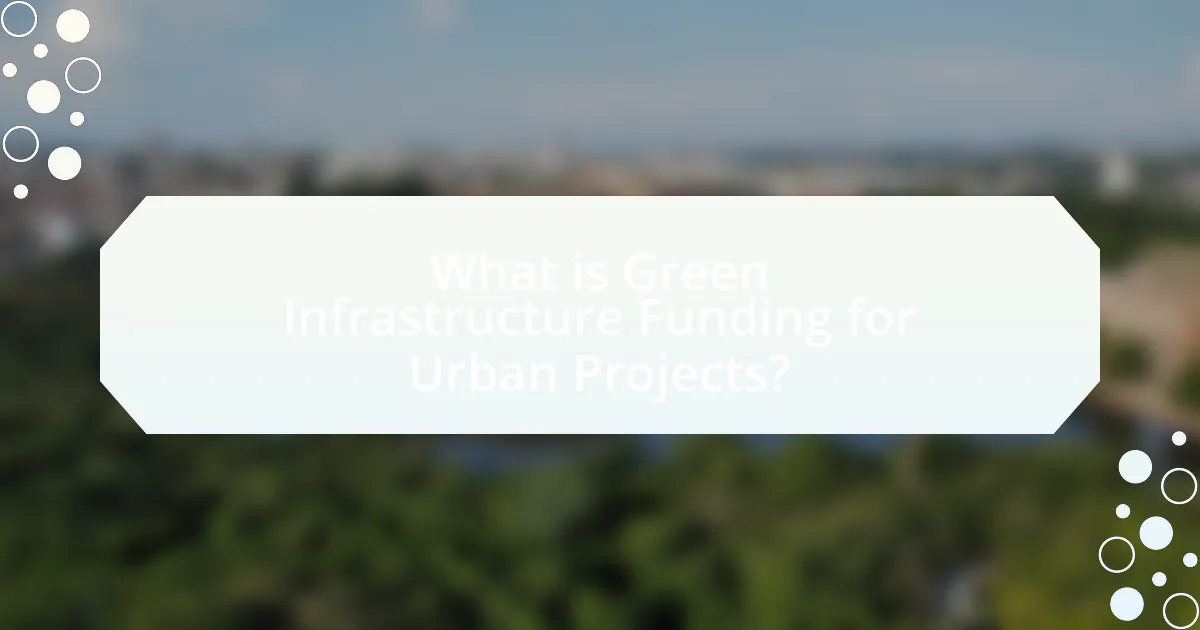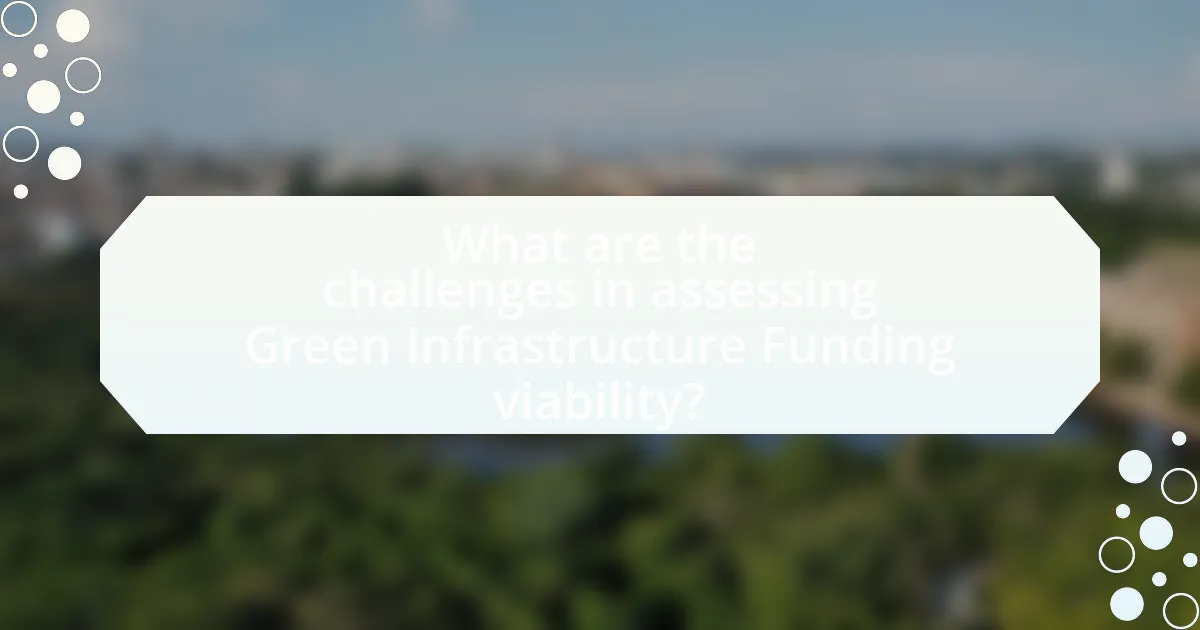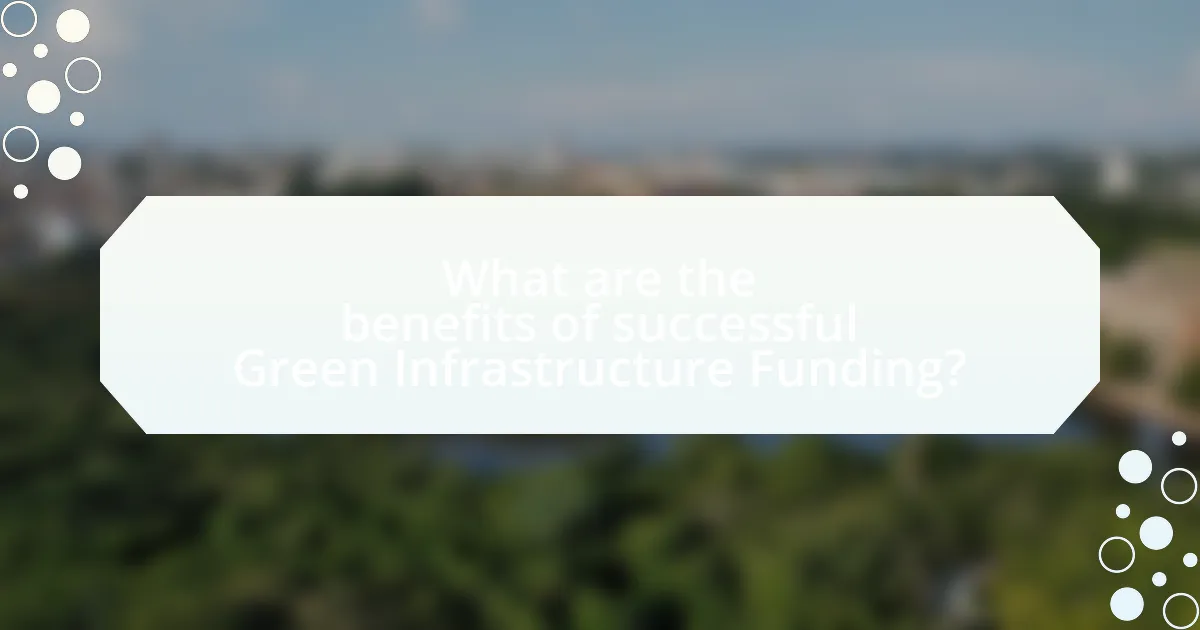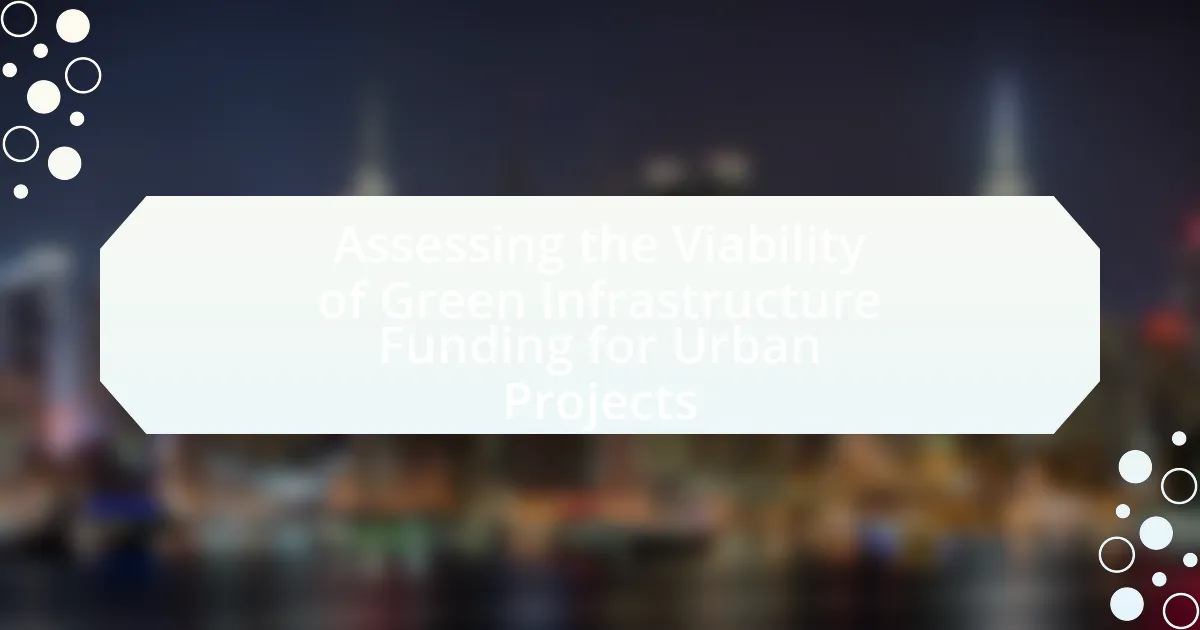Green Infrastructure Funding for Urban Projects refers to financial resources dedicated to implementing sustainable infrastructure solutions in urban areas, such as green roofs and permeable pavements. This funding supports projects that enhance stormwater management, improve air quality, and promote biodiversity, yielding economic benefits like reduced flooding costs and improved public health. The article assesses the viability of such funding by examining key components, challenges, and factors influencing its effectiveness, including public perception and regulatory frameworks. It also explores strategies for overcoming financial barriers and enhancing funding outcomes through collaboration and innovative financing mechanisms.

What is Green Infrastructure Funding for Urban Projects?
Green Infrastructure Funding for Urban Projects refers to financial resources allocated to implement environmentally sustainable infrastructure solutions in urban areas. This funding supports projects such as green roofs, permeable pavements, and urban forests, which aim to enhance stormwater management, improve air quality, and promote biodiversity. According to the Environmental Protection Agency, investments in green infrastructure can yield significant economic benefits, including reduced flooding costs and improved public health outcomes.
How does Green Infrastructure Funding support urban development?
Green Infrastructure Funding supports urban development by providing financial resources for projects that enhance environmental sustainability and resilience in urban areas. This funding enables cities to implement green roofs, permeable pavements, and urban forests, which improve stormwater management, reduce urban heat, and enhance biodiversity. For instance, a study by the American Society of Civil Engineers found that green infrastructure can reduce stormwater runoff by up to 90%, significantly mitigating flooding risks in urban settings. Additionally, investments in green infrastructure can lead to increased property values and improved public health outcomes, as seen in cities like Philadelphia, where green initiatives have transformed neighborhoods and boosted local economies.
What are the key components of Green Infrastructure Funding?
The key components of Green Infrastructure Funding include public and private investment, grants and subsidies, financing mechanisms, and partnerships. Public and private investment provides the necessary capital for green infrastructure projects, while grants and subsidies help reduce upfront costs and incentivize implementation. Financing mechanisms, such as green bonds and low-interest loans, facilitate long-term funding solutions. Partnerships among government agencies, non-profits, and private entities enhance resource sharing and project effectiveness, as evidenced by successful initiatives like the U.S. Environmental Protection Agency’s Green Infrastructure Grant Program, which has funded numerous urban projects to improve water management and enhance community resilience.
How does Green Infrastructure Funding differ from traditional funding methods?
Green Infrastructure Funding differs from traditional funding methods primarily in its focus on sustainability and environmental benefits. Traditional funding often prioritizes immediate economic returns and infrastructure development without considering ecological impacts, while Green Infrastructure Funding emphasizes long-term environmental health, resilience to climate change, and community well-being. For example, the U.S. Environmental Protection Agency has noted that investments in green infrastructure can reduce stormwater runoff and improve water quality, which traditional funding methods may overlook. This approach not only addresses urban challenges but also integrates natural systems into urban planning, leading to more sustainable and livable cities.
Why is assessing the viability of Green Infrastructure Funding important?
Assessing the viability of Green Infrastructure Funding is important because it ensures that financial resources are allocated effectively to sustainable urban development projects. This assessment helps identify potential funding sources, evaluate the economic feasibility of green initiatives, and determine their long-term benefits, such as reduced flooding and improved air quality. For instance, a study by the Environmental Protection Agency found that green infrastructure can provide up to $3.2 billion in annual benefits through stormwater management and energy savings. Therefore, a thorough evaluation of funding viability is crucial for maximizing environmental and economic returns in urban settings.
What factors influence the viability of Green Infrastructure Funding?
The viability of Green Infrastructure Funding is influenced by several key factors, including policy support, financial mechanisms, stakeholder engagement, and environmental benefits. Policy support from local and national governments can create a favorable regulatory environment that encourages investment in green infrastructure projects. Financial mechanisms, such as grants, loans, and public-private partnerships, provide the necessary capital for implementation. Stakeholder engagement ensures community buy-in and collaboration, which is crucial for project success. Additionally, the quantifiable environmental benefits, such as improved air quality and stormwater management, can justify funding and attract further investment. These factors collectively determine the effectiveness and sustainability of funding for green infrastructure initiatives.
How does public perception affect the viability of Green Infrastructure Funding?
Public perception significantly influences the viability of Green Infrastructure Funding by shaping community support and political will. When the public views green infrastructure positively, it increases the likelihood of funding approval and allocation, as seen in cities like Philadelphia, where community engagement led to successful funding for green stormwater management projects. Conversely, negative perceptions, often stemming from misconceptions about costs or effectiveness, can hinder funding opportunities, as evidenced by studies showing that public skepticism can lead to reduced political backing and investment. Thus, fostering a positive public perception is crucial for securing and sustaining financial support for green infrastructure initiatives.

What are the challenges in assessing Green Infrastructure Funding viability?
Assessing the viability of Green Infrastructure Funding faces several challenges, including the complexity of quantifying environmental benefits, securing consistent funding sources, and navigating regulatory frameworks. The difficulty in measuring the long-term ecological and economic impacts of green infrastructure projects complicates the evaluation process, as traditional financial metrics may not fully capture these benefits. Additionally, funding for such initiatives often relies on fluctuating public and private investments, making financial sustainability a concern. Regulatory hurdles can also impede project implementation, as varying local, state, and federal policies may create inconsistencies in funding eligibility and project approval processes. These factors collectively hinder a clear assessment of funding viability for green infrastructure projects.
What financial barriers exist for Green Infrastructure projects?
Financial barriers for Green Infrastructure projects include high initial capital costs, limited access to funding sources, and uncertainty in long-term financial returns. High initial capital costs can deter investment, as many green projects require significant upfront expenditures for planning, design, and implementation. Limited access to funding sources arises from the niche nature of green infrastructure, which may not be prioritized by traditional funding mechanisms. Additionally, uncertainty in long-term financial returns can make it difficult for stakeholders to justify investments, as the benefits of green infrastructure, such as improved ecosystem services and reduced urban heat, may take years to materialize. These barriers collectively hinder the widespread adoption and implementation of green infrastructure initiatives.
How do economic conditions impact funding availability?
Economic conditions significantly influence funding availability by affecting investor confidence, interest rates, and government budgets. During periods of economic growth, funding sources such as banks and venture capitalists are more likely to invest in projects, including green infrastructure, due to increased liquidity and optimism about returns. Conversely, in economic downturns, funding becomes scarce as lenders tighten credit and investors become risk-averse, leading to reduced capital for urban projects. For instance, the 2008 financial crisis resulted in a dramatic decline in funding for infrastructure projects, with public and private investments dropping by over 30% in many regions. This correlation between economic health and funding availability underscores the importance of stable economic conditions for the success of green infrastructure initiatives.
What role do regulatory frameworks play in funding challenges?
Regulatory frameworks significantly influence funding challenges by establishing the rules and guidelines that govern financial support for projects. These frameworks can either facilitate or hinder access to funding by defining eligibility criteria, compliance requirements, and risk assessments. For instance, stringent regulations may deter investors due to perceived risks or increased costs associated with compliance, while supportive frameworks can attract funding by providing incentives such as tax breaks or grants. According to a report by the World Resources Institute, clear and supportive regulatory environments can enhance investment in green infrastructure by up to 30%, demonstrating the critical role these frameworks play in shaping funding landscapes.
How can stakeholders overcome challenges in Green Infrastructure Funding?
Stakeholders can overcome challenges in Green Infrastructure Funding by collaborating to create innovative financing mechanisms. Collaborative efforts among government agencies, private investors, and community organizations can lead to the development of public-private partnerships, which have been shown to effectively pool resources and share risks. For instance, the Green Infrastructure Finance Program in New York City successfully leveraged $1 billion in funding through such partnerships, demonstrating that diverse stakeholder engagement can enhance financial viability. Additionally, stakeholders can advocate for policy changes that prioritize green infrastructure investments, as seen in cities like San Francisco, where local legislation has facilitated increased funding for sustainable projects.
What strategies can be employed to enhance funding viability?
To enhance funding viability for green infrastructure projects, stakeholders can adopt a multi-faceted approach that includes diversifying funding sources, establishing public-private partnerships, and demonstrating measurable outcomes. Diversifying funding sources, such as tapping into federal grants, state funding, and private investments, increases financial stability and reduces reliance on a single source. Public-private partnerships leverage resources and expertise from both sectors, fostering innovation and shared risk. Additionally, demonstrating measurable outcomes through data collection and impact assessments can attract funders by showcasing the effectiveness and benefits of green infrastructure, as evidenced by studies indicating that projects with clear metrics receive more funding support.
How can collaboration among stakeholders improve funding outcomes?
Collaboration among stakeholders can significantly improve funding outcomes by pooling resources, expertise, and networks to create more comprehensive and appealing funding proposals. When diverse stakeholders, such as government agencies, non-profits, and private sector partners, work together, they can leverage their unique strengths and insights to address complex urban challenges more effectively. For instance, a study by the Urban Institute found that collaborative funding initiatives often result in higher success rates for grant applications, as they demonstrate a unified approach and shared commitment to project goals. This collective effort not only enhances the credibility of the funding request but also increases the likelihood of attracting larger investments, as funders are more inclined to support projects with broad stakeholder backing.

What are the benefits of successful Green Infrastructure Funding?
Successful Green Infrastructure Funding provides multiple benefits, including enhanced environmental sustainability, improved public health, and increased economic resilience. These funding initiatives facilitate the development of green spaces, which help manage stormwater, reduce urban heat, and improve air quality. For instance, a study by the American Society of Civil Engineers found that green infrastructure can reduce stormwater runoff by up to 90%, significantly mitigating flooding risks. Additionally, green spaces promote physical activity and mental well-being, contributing to healthier communities. Economically, investments in green infrastructure can yield a return of $2 to $4 for every dollar spent, as reported by the National Oceanic and Atmospheric Administration, through increased property values and reduced healthcare costs.
How does Green Infrastructure Funding contribute to sustainability in urban areas?
Green Infrastructure Funding contributes to sustainability in urban areas by financing projects that enhance environmental quality and resilience. This funding supports the development of green roofs, permeable pavements, and urban forests, which help manage stormwater, reduce urban heat, and improve air quality. For instance, a study by the U.S. Environmental Protection Agency indicates that green infrastructure can reduce stormwater runoff by 30-50%, thereby mitigating flooding and water pollution. Additionally, investments in green spaces can increase biodiversity and provide recreational opportunities, further promoting community well-being and ecological health.
What environmental benefits arise from effective Green Infrastructure projects?
Effective Green Infrastructure projects provide significant environmental benefits, including improved stormwater management, enhanced biodiversity, and reduced urban heat. These projects utilize natural systems to manage water runoff, which can decrease flooding and water pollution by filtering contaminants. For instance, a study by the U.S. Environmental Protection Agency found that green roofs can reduce stormwater runoff by up to 65%. Additionally, Green Infrastructure promotes biodiversity by creating habitats for various species, which is crucial for ecosystem health. Furthermore, these projects can lower urban temperatures by providing shade and increasing evapotranspiration, contributing to energy savings and improved air quality.
How does Green Infrastructure Funding enhance community resilience?
Green Infrastructure Funding enhances community resilience by providing financial resources for sustainable projects that mitigate environmental risks and improve urban ecosystems. These projects, such as green roofs, permeable pavements, and urban forests, reduce flooding, improve air quality, and promote biodiversity. For instance, a study by the National Oceanic and Atmospheric Administration (NOAA) found that green infrastructure can reduce stormwater runoff by up to 65%, significantly decreasing the risk of urban flooding. Additionally, communities that invest in green infrastructure often experience increased social cohesion and public health benefits, as these projects create green spaces that foster community interaction and physical activity.
What best practices can be adopted for effective Green Infrastructure Funding?
Effective Green Infrastructure Funding can be achieved by adopting a multi-faceted approach that includes leveraging public-private partnerships, utilizing grant funding, and implementing innovative financing mechanisms. Public-private partnerships allow for shared investment and risk, enhancing project viability and sustainability. For instance, the Green Infrastructure Grant Program in New York City has successfully funded numerous projects through collaboration between government and private entities. Additionally, utilizing grant funding from federal and state sources, such as the Environmental Protection Agency’s (EPA) Water Infrastructure Finance and Innovation Act (WIFIA), provides essential financial support for green infrastructure initiatives. Innovative financing mechanisms, such as green bonds, enable municipalities to raise capital specifically for environmentally beneficial projects, as demonstrated by the issuance of over $10 billion in green bonds globally in 2020 alone. These best practices collectively enhance the effectiveness and sustainability of funding for green infrastructure projects.
How can project planning improve funding success rates?
Effective project planning can significantly improve funding success rates by providing a clear roadmap that outlines objectives, timelines, and resource allocation. A well-structured plan demonstrates to potential funders that the project is feasible and strategically thought out, which increases their confidence in the investment. Research indicates that projects with detailed planning are 30% more likely to secure funding, as they can effectively communicate their goals and anticipated outcomes. Additionally, comprehensive project plans often include risk assessments and mitigation strategies, further reassuring funders about the project’s viability and sustainability.
What role does community engagement play in securing funding?
Community engagement plays a critical role in securing funding by fostering trust and demonstrating community support for projects. Engaged communities are more likely to advocate for funding, as they can articulate the benefits and needs associated with green infrastructure initiatives. Research indicates that projects with strong community backing often receive higher funding amounts; for instance, a study by the Urban Institute found that community-supported projects are 30% more likely to secure grants. This engagement not only enhances the credibility of funding proposals but also aligns project goals with community priorities, making them more attractive to funders.
What are the future trends in Green Infrastructure Funding for urban projects?
Future trends in Green Infrastructure Funding for urban projects include increased public-private partnerships, innovative financing mechanisms, and a focus on resilience and sustainability. Public-private partnerships are becoming more common as cities seek to leverage private investment to fund green infrastructure initiatives, which can enhance project viability and reduce public expenditure. Innovative financing mechanisms, such as green bonds and impact investing, are gaining traction, allowing municipalities to attract capital specifically for environmentally beneficial projects. Additionally, there is a growing emphasis on resilience to climate change, prompting funding strategies that prioritize projects designed to mitigate flooding, heat, and other climate-related impacts. These trends are supported by the increasing recognition of the economic benefits of green infrastructure, which can lead to cost savings in stormwater management and improved public health outcomes.
How is technology shaping the future of Green Infrastructure Funding?
Technology is significantly shaping the future of Green Infrastructure Funding by enhancing data analytics, improving project management, and facilitating innovative financing models. Advanced data analytics tools enable stakeholders to assess environmental impacts and cost-effectiveness more accurately, leading to better-informed funding decisions. For instance, geographic information systems (GIS) allow for precise mapping of green infrastructure needs, which can attract targeted investments. Additionally, project management software streamlines collaboration among various stakeholders, ensuring efficient use of funds and resources. Furthermore, technology fosters innovative financing models such as green bonds and crowdfunding platforms, which have seen a rise in popularity; for example, the global green bond market reached $269.5 billion in 2020, demonstrating a growing trend in sustainable investment. These technological advancements collectively enhance the viability and attractiveness of green infrastructure projects, ultimately driving increased funding opportunities.
What emerging funding sources are available for Green Infrastructure projects?
Emerging funding sources for Green Infrastructure projects include green bonds, public-private partnerships, and federal grants specifically aimed at sustainability initiatives. Green bonds, which are debt securities issued to finance environmentally friendly projects, have gained traction, with the global green bond market reaching over $1 trillion in issuance by 2021. Public-private partnerships leverage both public funding and private investment, allowing for shared risk and resources in developing infrastructure. Additionally, federal grants, such as those from the Environmental Protection Agency’s (EPA) Water Infrastructure Finance and Innovation Act (WIFIA), provide significant financial support for innovative water-related projects that enhance green infrastructure. These funding sources are increasingly recognized for their potential to support urban sustainability efforts effectively.

Leave a Reply